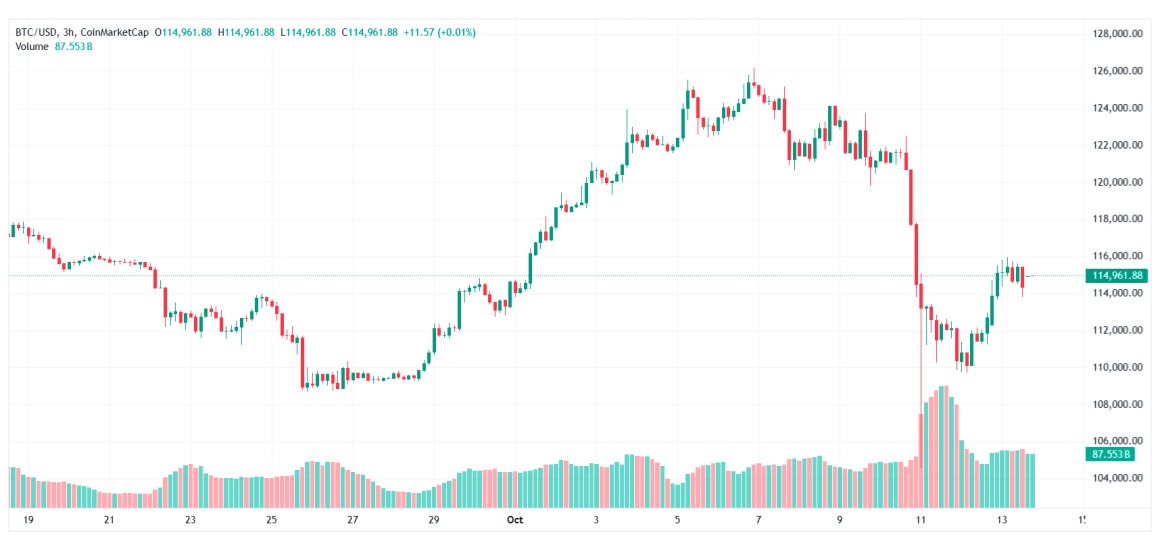
The sharp decline in the cryptocurrency market on October 10–11, 2025, was one of the biggest events of the year and demonstrated the sensitivity of markets to geopolitical and macroeconomic shocks.
Context and chronology of the collapse
Throughout early October 2025, the crypto market was at its peak: Bitcoin and top altcoins reached new all-time highs, and market sentiment was extremely bullish. However, on the evening of October 10, #US President Donald Trump announced new 100% tariffs on imports from #China. This news instantly affected not only traditional exchanges but also cryptocurrencies, which investors began to sell off en masse as risky assets.
The main phase of the collapse lasted about half an hour: on the night of October 10-11, Bitcoin fell from $122,000 to $102,000 on some exchanges, and the total market capitalization shrank by $280-300 billion. #Altcoins fell by 20-80%, and in some cases (TON, SOL) — almost twice as much.

The main reasons for the decline
- Geopolitical shock:
The news of a sharp escalation in the US-China trade war triggered panic selling. For the market, this is a signal to reassess risks — investors are beginning to move away from unstable assets, among which cryptocurrencies have historically occupied a leading position. - Technical overbought conditions:
Before the collapse, the market was in an overheated phase: the fear and greed index exceeded 74, and technical indicators (such as RSI) were in the extreme range (>80). The combination of greed and record highs traditionally makes the market vulnerable: any news event can lead to a rapid and deep correction. - Wave of liquidations of leveraged positions:
The fall in prices triggered automatic liquidations of margin positions. Overnight, more than $19 billion in long positions were forcibly closed on the market — a historic anti-record. This caused a chain reaction: falling prices generated new liquidations and accelerated the avalanche of sell-offs. - Alternative macroeconomic factors:
Investors feared not only trade tariffs, but also the possible continuation of the #Fed's tightening policy, rising government bond yields, and a slowdown in the stock markets. These fears increased indecision even among long-term crypto holders.
Consequences and recovery dynamics
- Millions of traders lost their funds due to liquidations alone — recorded losses exceeded $19–20 billion.
- At one point, #Bitcoin fell to $102–108 thousand, #ETH fell to $3,400–3,500, and Solana and TON corrected by 40–80% from their highs.
- On the morning of October 11, a partial recovery was observed: Bitcoin tested $108–112 thousand, and altcoins and memecoins rose slightly above their local lows.
- Many large investors and funds are not rushing to return: market sentiment remains nervous, and participants prefer to wait for new news on tariffs and China's reaction.
Prospect assessment: correction or the beginning of a bearish trend?
Analysts disagree on the nature of the decline:
- Optimists consider it a “healthy #correction” after a prolonged bullish rally.
- Signals in favor of growth: if the Federal Reserve signals a softening of policy and the tariff rhetoric shifts to a negotiating tone, a rapid recovery to new highs is possible (forecasts for BTC: $120-135 thousand, for ETH — $5 thousand by the end of the year).
- The bearish scenario is linked to an escalation of the trade conflict, a new wave of panic, and regular coinciding declines in the stock markets. In this case, Bitcoin could get stuck in the $100,000–115,000 range, and the market will fluctuate on the wave of news and speculation.
Behavioral and technical features
- The massive outflow of liquidity showed that large players are quick to take advantage of panic to “reset” overheating and build positions at lower prices.
- An extremely rapid drawdown phase (10–15 minutes) is a characteristic feature of the crypto market with a high proportion of algorithmic and credit transactions, which amplifies both the sharpness of the decline and technical pullbacks.
- The altcoin sector (especially memecoins and AI tokens) proved to be the most vulnerable and unstable to shocks, while traditional crypto assets, despite the decline, quickly recovered partially.
Conclusion and strategic recommendations
The October 2025 crash was a combination of macroeconomic risk, technical weakness, and the human factor of mass panic. In the medium term, further movement will be tied to external news and macroeconomics. Risk management, accounting for overbought conditions, cautious use of leverage, and monitoring key support levels remain the main recommendations for market participants.
This event demonstrates that even during an uptrend, large drawdowns can be sudden, and the only sustainable strategy is conscious diversification and vigilance towards market triggers.




























